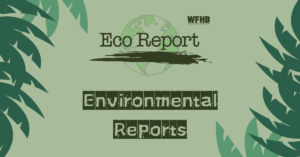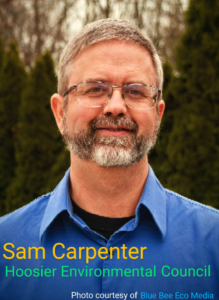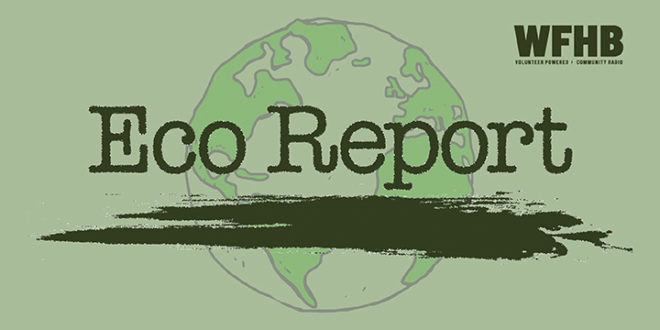Podcast: Play in new window | Download (Duration: 30:45 — 28.2MB)
This week’s Eco Report feature is part four of Environmental Correspondent Zyro Roze’s interview with Sam Carpenter, the new Executive Director of the Hoosier Environmental Council, on legislation proposed to lawmakers of the Indiana General Assembly in this year’s non-budget Legislative Session. The full four-part interview will be available online after the show as an E.R.X Eco Report EXTRA, to be found at wfhb.org.

Recently, the Bloomington Herald Times published a story about the plastic industry and how it has been spreading misconceptions about recycling. One of the most widespread misconceptions is that all plastics can be recycled. Not true. Only certain types are economically and technically able to be recycled. Some plastics, likePVC, are very problematic to recycle and can contaminate streams. Many consumers believe that the plastic packaging they dispose of in recycling bins will be recycled. A significant portion of plastic waste, especially single-use packaging, ends up in landfills or incinerators.
Recycling is often promoted as the ultimate solution to plastic pollution. The reality is that only a fraction of plastic waste is effectively recycled and much of it still ends up in the environment. Biodegradable and compostable plastics are a sustainable alternative. However, these materials often require specific conditions to break down, and if they end up in a landfill, they may not degrade as intended. Recycling plastics is costly and complex. It is cheaper to produce new plastic from raw materials than to recyle existing plastic. It is crucial for consumers to be aware of the misconceptions and to advocate for more transparent and sustainable practices, such as reducing the use of plastics and promoting the use of alternative materials.
One of the common complaints about solar panels is that they take up valuable agricultural land. This factor has canceled several proposed projects in Indiana. A story from Inside Climate Change finds that ranchers in Wyoming have demonstrated a useful example. BrightNight – a global energy company, has proposed to build more than 1 million solar panels, a battery storage facility and a few miles of above-ground transmission lines on a 4,738 acres of private land run by the Tillard ranching family near Glenrock. The Dutchman Project, as it is called, is notable neither for its generation nor its storage capacity but for the creatures moseying beneath its panels. The base of each sun-tracking panel will be several feet off the ground, allowing enough room for the Tillard’s sheep to continue grazing.
In a state whose ranching industry predates its inclusion in the union, pairing solar generation with livestock grazing or other agricultural practices, a technique called “agrivoltaics,” could forge an unlikely alliance between two industries—one ancient; the other, high tech — that typically compete for resources. At the conclusion of their February 6 hearing regarding the Dutchman project, Converse County Commissioners directed the county attorney to draft an order of approval, indicating they would likely grant the project its permit later this month. This leaves us with one question. Why, in a state where the wind always blows, this ranch chose solar over wind.
The current mass extinction event is at an early stage. E. O. Wilson, the Dean of American biology, predicted the globe will extinguish one million species. Today, some conclude this assessment is too low. There are many reasons for this extinction event: loss of habitat is the primary cause. Humans occupy every livable space on Earth. Climate change plays a significant role. Poaching is another contributor. One we might not think of is cats: people take their cats to islands with flightless birds, and soon the birds disappear forever.
Solving this problem is straightforward: humans created the problem and we must solve it. Saving many species is not a matter of knowing what to do, but rather, the will to do it. For example, the number of right whales in the North Atlantic has fallen from 600 at the beginning of this century, to about 350 today. The main killer is ship strikes. These mostly occur near ports involved in worldwide trade. The big container ships are not trying to hit a whale, and often are not even aware that they have hit one. Most of the right whales have moved north out of the New England area because the water is too warm and little food (copepods) remains. Most, during summer, are now in the Gulf of St. Lawrence, and are thus at risk from all the boat traffic. A solution is to limit boat speed to 10 knots in areas where there are whales, but for the shippers, time is money and they are often unwilling to slow down.
Another issue is becoming entangled in lobster gear. A common lobster set consists of a buoy with attached rope that goes to the bottom and is attached to a lobster pot (aka traps) and then a line with perhaps ten traps, ending by a rope to the surface. Thus, there are two ropes for every set. For most of the year, just in the U.S., there are about 2 million vertical ropes in the water for most of the year. If a whale hits a rope, there is some probability of the rope wrapping around a flipper or tail (aka, fluke). After dragging around the rope (and possibly some lobster traps) for a year or two, the rope often has cut into the whale and the whale bleeds to death or dies of starvation.
The problem could be cut in half if the rope at the non-hauling end broke at 1000 lb. An adult right whale can break a rope at that breaking strength. The rope at the hauling end is much stronger because the traps can be entangled with the bottom. The problem is the lobstermen have rejected the use of a weak rope because occasionally they need to haul using the non-hauling rope. Another solution is to use no vertical rope. The ropes are carried to the bottom by a device that can trigger the release of the rope. Thus, when the lobsterman arrives at the exact location, he activates the device and the rope floats to the surface. Clever. The problem is these release systems are expensive, and some trawlers may carry the set several miles from its original location. What might work is one weak rope and one strong rope with a release device. Though this would seem to solve all problems, this concept has not been tested. And there is the issue of warming waters off New England, which is driving the lobsters north. Next week, the discussion will be on how to protect the few remaining cold-water species, such as codfish.
Parts of this story come from the New York Times. Climate change is stretching the length of time in parts of the Far North that go without sea ice, which polar bears rely on to hunt their preferred prey: blubbery, calorie-rich seals. When the ice melts in summer, the bears move onto land and face two options. They can rest and slow down to a state approaching hibernation, or they can forage for alternative food like berries, bird eggs and small land animals. Scientists tracking 20 polar bears in Manitoba, below the Arctic Circle at the southern end of the animals’ range, found that the option the polar bears chose didn’t make much difference.
Bears who foraged generally got just enough calories from their small meals to replenish the energy they spent finding them, but not enough to maintain their body mass. “Terrestrial foods are not adequate to prolong the period that polar bears can survive on land,” said Anthony Pagano, a wildlife biologist at the U.S. Geological Survey and the lead author of a study based on the research, published recently in Nature Communications. In western Hudson Bay, the ice-free period is three weeks longer now than it was in the 1970s, and polar bears currently spend about 130 days on land during the year. Scientists estimate that, going forward, there will be five to 10 more days without sea ice each decade. It is estimated that the polar bear population of the western Hudson Bay area, an area extending from the Manitoba-Ontario boundary through to Chesterfield Inlet in Nunavut, is approximately 935 miles. The population of polar bears in this region has dropped by thirty percent over the last five years.

This week’s Eco Report feature is part four of Environmental Correspondent Zyro Roze’s interview with H.E.C. Executive Director Sam Carpenter on legislation supported or opposed by the Hoosier Environmental Council in the 2024 Legislative Session at the State Capitol relating to groundwater, the LEAP Pipeline project and phasing out fossil fuels. The full four-part interview is available online as an E.R.X Eco Report EXTRA at wfhb.org.

-
A Maple Syrup Made Easy Workshop is scheduled for Saturday, February 24th, from noon to 1:30 pm at the RCA Community Park in Bloomington. This hands-on workshop will discuss tree identification, equipment, collection and sugaring techniques. Register at bloomington.in.gov/parks.
-
The Winter Hike Series at Brown County State Park continues with the CCC Ruins and Deserter’s Cave hike on Saturday, February 24th, from 11 am to 1 pm. This is a 1.5 mile round trip hike that will take you to the Civilian Conservation Corps area then you will hike to the Deserter’s Cave which is a very rugged section of off-trail hiking.
-
Take a Full Moon Hike at Spring Mill State Park on Saturday, February 24th, from 8 to 9 pm. Experience the park at night while learning the history and folklore of the Full Snow Moon. Meet at the Lakeview Activity Center for this 1-mile hike on Trail 1 and 4.
-
Celebrate February 29th with a Leap Year Hike at Spring Mill State Park from 1 to 2 pm. Take advantage of the this extra day as you hike through nature on Trail 4 and learn leap year facts, superstitions and folklore. Meet at the Sycamore Shelter House.
-
Finish up the Brown County Winter Hike Series with a Brown County Dog Hike on Saturday, March 3rd, from 11 am to 12:30 pm. Meet at the Ogle Lake Parking lot for a moderate hike on Trail 7. Your dog must be on a six-foot leash.
Credits:
This week’s headlines were written by Norm Holy and Julianna Dailey.
Today’s news feature was produced Zyro Roze and edited by Kade Young.
Julianna Dailey assembled the script which was edited by the Eco Report team.
Julianna Dailey compiled our events calendar.
Kade Young and Noelle Herhusky-Schneider produced today’s show.
Branden Blewett is our engineer.
Anchors are Julianna Dailey and Robert Shull.
 WFHB Bloomington Community Radio
WFHB Bloomington Community Radio


